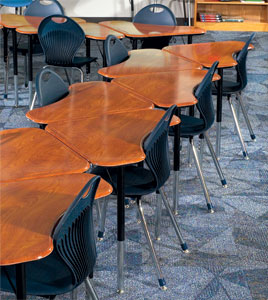
From the moment children walk into a classroom for the first time, they are engaged in learning. School is a new experience for them, and all of a sudden there’s structure in their daily lives. They’re expected to settle down and pay attention to the teacher instead of playing all day. From this point on, they’ll embark on a journey of learning that will last for at least the next 12 years, and possibly four or more years beyond that.
People who devote their lives to teaching children should be commended. They’re making a difference in the lives of the next generation. However, there are challenges that go along with this occupation. One of the challenges that teachers are often faced with is how to keep small children engaged with the learning process as they move through elementary school. They know it’s important to make learning fun so that children absorb the information presented, and are able to retain and build on it in the future.
A good way to keep children engaged in the learning process is through the use of classroom design and layout. Most teachers agree that the old-fashioned method of lining desks up in rows facing the front of the room, while a teacher lectures to the class all day is ineffective, especially with young children. It doesn’t engage them enough to keep them interested. Many teachers have started experimenting with classroom layout design to see how it impacts their students’ ability to absorb and retain information, and apply what they’ve learned. They’ve found that by using different classroom layouts and varying the position of school furniture, they’re better able to hold students’ attention, and the children seem to learn more easily.
One way teachers use classroom layout to their advantage is by rearranging the configuration of the student desks in the classroom. Two of the best layouts for desks are the cluster and the horseshoe. The cluster design (four desks in a “quad”) facilitates group discussion among students and keeps them engaged on a smaller group level. The horseshoe layout allows everyone to have a front-row seat, and puts the teacher at the open end of the horseshoe. This layout also allows for group discussion, but on a larger scale. Either way, students stay engaged and can easily see and interact with both their peers and the teacher.
Another way to facilitate learning through the use of classroom design is by using school furniture to create various learning stations throughout the room. One corner may have soft chairs and shelves full of books so that children can practice reading in comfort. Another corner may have materials for the students to design their own books, using their growing writing and spelling skills. Yet another area of the room may contain numbers and blocks for use with math skills, or art supplies so the children can work on creating their own works of art. Having several stations throughout the room allows the students to practice independence and learn to make their own choices. By choosing what they’d like to do, they stay focused and engaged in the learning process.
Finally, children enjoy seeing what they’ve created. Seeing their artwork or projects displayed on bulletin boards, or on the walls gives students a sense of accomplishment and promotes pride in their work. The stronger the feeling that they’ve done something good, the harder they’ll try to do it again. This develops excellent students who care about the quality of work they do.
Being a kid is a tough job. There are lots of things to learn on the path to growing up. But there are steps teachers can take even in such mundane considerations as classroom design and school furniture to help facilitate this process and make it more enjoyable for their students. After all, the process of learning won’t stop once the students leave the classroom. The sooner they learn to enjoy the learning experience, the more successful they’ll be as adults.
